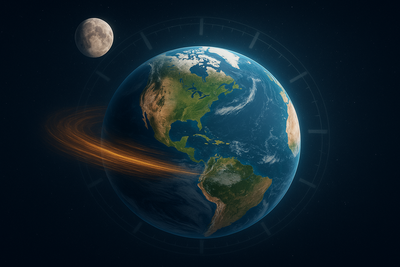Earth’s fastest spin: July 9 2025 to be one of the shortest days ever recorded, scientists eye rare negative leap second

The clocks say a day lasts 24 hours, yet today, July 9 2025, will come up just a bit short. Scientists who track the planet’s spin expect Earth to finish its turn about 1.3 to 1.6 milliseconds early. That sliver of time is so small most people will never notice, but it is still one of the briefest days since atomic clocks began keeping score in 1960.
Why the planet is speeding up
Scientists say the acceleration is linked partly to the Moon’s current high declination—when its orbit takes it far north or south of Earth’s equator— which subtly redistributes angular momentum and lets Earth spin a hair faster.Other factors can help or hurt the trend. Big earthquakes move mass toward or away from Earth’s center. Shifts in ocean currents and winds change how weight is spread across the surface. Even melting ice at the poles can alter spin by moving water toward the equator. No single event explains the full speed-up, which is why many experts call the change “unusual” and want to keep watching future data.
Three quick days, then back to normal
Today is only the first of three short turns. Calculations show July 22 and August 5 will each finish early as well. After August the spin should creep back toward its longer pace, although tiny day-to-day swings are always possible.
What a millisecond means for daily life
A millisecond is one-thousandth of a second. For everyday tasks—walking the dog, cooking pasta, paying bills—it means nothing at all. Phones, computers, and power grids keep time by syncing to the official atomic clock signal, not to sunrise and sunset. Yet the atomic clock must still match the sky over years and decades. If Earth keeps running fast, timekeepers may have to subtract a ‘negative leap second’ sometime between 2026 and 2029 to bring the two systems back together. That step has never happened before.
No risk, just a scientific puzzle
Geophysicist Duncan Agnew at the Scripps Institution of Oceanography says the shorter days are “significant but not scary.” Planes will land, tides will come and go, and coffee will still brew on schedule. The real interest is academic. Understanding why the spin changes helps experts build better climate models, improve satellite navigation, and test ideas about Earth’s molten core.
What happens next
Time-watching agencies will keep logging each day’s exact length. If a fresh pattern appears—faster or slower—they will adjust future leap seconds. Blink and the extra millisecond is gone, but the question of why our planet sped up remains wide open for science to solve.





